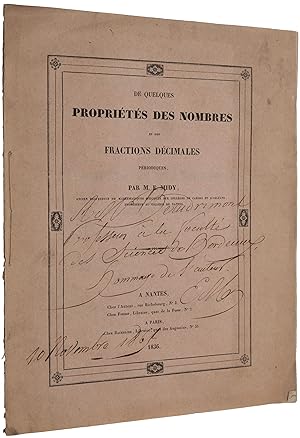midy étienne (1 résultats)
Type d'article
- Tous les types d'articles
- Livres (1)
- Magazines & Périodiques
- Bandes dessinées
- Partitions de musique
- Art, Affiches et Gravures
- Photographies
- Cartes
-
Manuscrits &
Papiers anciens
Etat
- Tous
- Neuf
- Ancien ou d'occasion
Reliure
- Toutes
- Couverture rigide
- Couverture souple
Particularités
- Edition originale
- Signé
- Jaquette
- Avec images
- Sans impression à la demande
Pays
Evaluation du vendeur
-
De quelques proprietes des nombres et des fractions decimales periodiques
Edité par the author & Forest; Bachelier, Nantes; Paris, 1836
Vendeur : SOPHIA RARE BOOKS, Koebenhavn V, Danemark
Membre d'association : ILAB
Edition originale
First edition. MIDY'S THEOREM ON REPEATING DECIMALS. First edition, presentation copy, extremely rare, of the privately printed proof of Midy's Theorem. "It is well known that a real number is rational if and only if its decimal expansion is a repeating decimal. For example, 2/7 = .285714285714 . Many students also know that if n/m is a rational number reduced to lowest terms (that is, n and m relatively prime), then the number of repeated digits (we call this the length of period) depends only on m. Thus all fractions with denominator 7 have length of period 6. A sharp-eyed student may also notice that when the period (that is, the repeating digits) for 2/7 is split into its two half-periods 285 and 714, then the sum 285 + 714 = 999 is a string of nines. A little experimentation makes it appear likely that this is always true for a fraction with the denominator 7, as well as for fractions with denominators 11, 13, or 17. A natural conjecture is that all primes with even length of period (note that many primes, such as 3 and 31, have odd length of period) will have a similar property. This conjecture is, in fact, true but it is unfortunately not a criterion for primeness, since many composite numbers (such as 77) also have the property. The relevant theorem appears not to be well known, although it was discovered many years ago. (L. E. Dickson attributes the result to E. Midy, Nantes, 1836)" (Leavitt). Midy's Theorem languished in obscurity until 2004, when Yale student Brian Ginsberg published an extension of it in his paper 'Midy's (nearly) secret theorem -- an extension after 165 years' (College Mathematics Journal 35 (2004), pp. 26-30).Ginsberg showed that Midy's theorem can be extended to the case in which the period is divided into k-digit numbers, in which case they sum to 10k - 1 (Midy's theorem being the case k = 3). Very little is known about Midy (ca. 1775-1850), a professor of mathematics at the college de Nantes, apart from the fact that he also taught at the Colleges of Cahors and d'Orleans, and that he published a handful of brief mathematical and stenographic works at his own expense in the 1830s.OCLC lists five copies worldwide (Bibliotheque Nationale, Bordeaux, Toulouse, Columbia and NYPL). Provenance: Presentation Copy, inscribed by Midy to Alexandre-Edouard Baudrimont (1806-80) on the front wrapper: 'A M. Baudrimont Professeur a la Faculté des Sciences de Bordeaux. Hommage de l'auteur E. Midy, 10 Novembre 1861.' Baudrimont was professor of chemistry at the University of Bordeaux from 1848-1880 and author of works on industrial chemistry and the Basque language. "Midy's name is spelledMeidy in some records.He was probably already teaching when Napoléoninstituted the lycées,in 1802.Midy himself advertised he had taughtmathématiques spécialesat Cahors (1821-1826) and Orléans (1826-1832) before moving to Nantes. "At theCollège Royal de Nantes(the futureLycée Clémenceau)Midy taught mathématiques élémentaires from 1833 to 1837.That post was entrusted to a young normalien(Alexandre Lepord, ENS1834)when Midy was promoted to teach mathématiques spécialesagain in 1837-1838 (after M.Dorveau resigned).Midy would be replaced in this capacity by M. Gascheau (previously, professor ofphysics)when a ministerial decree(1838-11-17)allowed him to retire. "In Nantes,Etienne Midy livedat 3, rue Richebourg, next to his workplace" (). Since Ginsberg's work, a number of mathematicians have published further generalizations of Midy's Theorem, including Gupta and Sury ('Decimal expansion of 1/p and subgroup sums,' Integers: Electronic Journal of Combinatorial Number Theory 5 (2005)); Gil and Winer ('On cyclic numbers and an extension of Midy's theorem,' http: ///pdf/math.NT/);Lewittes ('Midy's theorem for periodic decimals,' Integers: Electronic Journal of Combinatorial Number Theory 7 (2007)); Hamarsheh ('On Ginsberg theorem in Base b,' International Journal of Contemporary Mathematics 8 (2013), pp. 633-636) andKemeny ('The Secret Theory of M. E. Midy - Casting in Nines,' A Mispelt Blog. John , 6 Sep. 2007. Leavitt, 'A theorem on repeating decimals' (/mathfacpub/48/). 4to (261 x 208 mm), pp. 21 (light dampstain in one corner). Original pink printed wrappers (light soiling, splits in upper and lower spine, faint withdrawal stamp from Library of Congress on rear endpaper).


